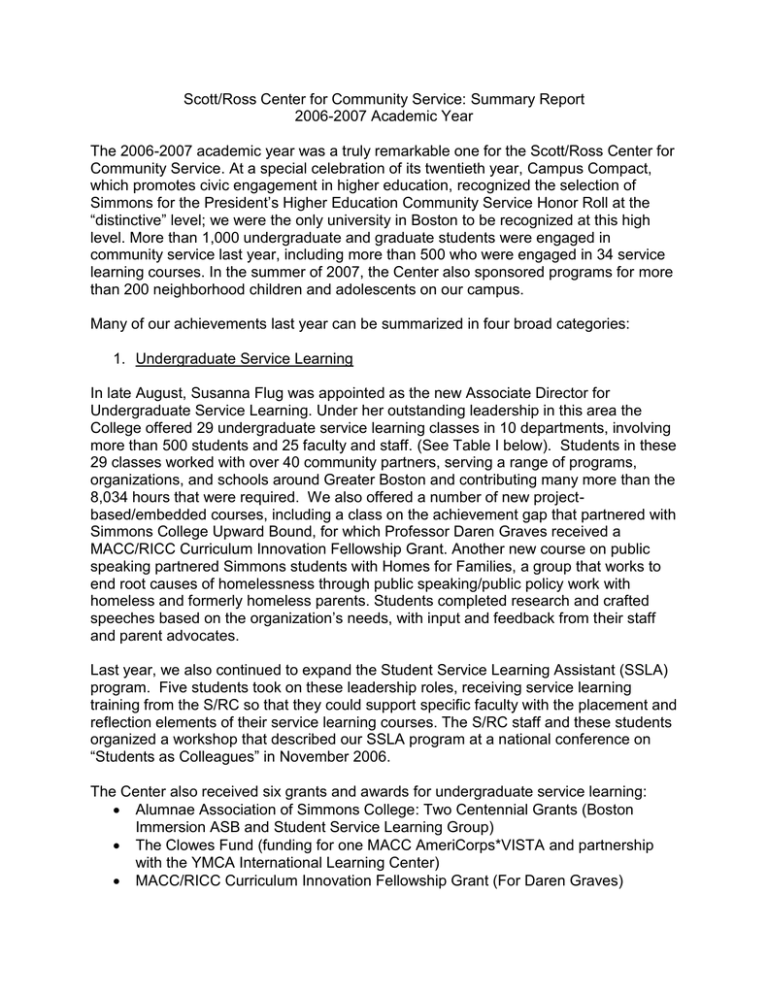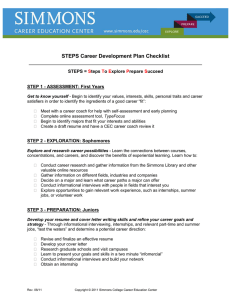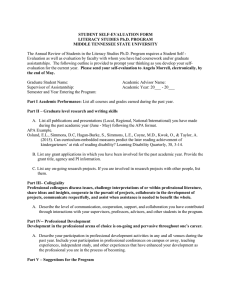Scott/Ross Center Annual Report 2006-2007
advertisement

Scott/Ross Center for Community Service: Summary Report 2006-2007 Academic Year The 2006-2007 academic year was a truly remarkable one for the Scott/Ross Center for Community Service. At a special celebration of its twentieth year, Campus Compact, which promotes civic engagement in higher education, recognized the selection of Simmons for the President’s Higher Education Community Service Honor Roll at the “distinctive” level; we were the only university in Boston to be recognized at this high level. More than 1,000 undergraduate and graduate students were engaged in community service last year, including more than 500 who were engaged in 34 service learning courses. In the summer of 2007, the Center also sponsored programs for more than 200 neighborhood children and adolescents on our campus. Many of our achievements last year can be summarized in four broad categories: 1. Undergraduate Service Learning In late August, Susanna Flug was appointed as the new Associate Director for Undergraduate Service Learning. Under her outstanding leadership in this area the College offered 29 undergraduate service learning classes in 10 departments, involving more than 500 students and 25 faculty and staff. (See Table I below). Students in these 29 classes worked with over 40 community partners, serving a range of programs, organizations, and schools around Greater Boston and contributing many more than the 8,034 hours that were required. We also offered a number of new projectbased/embedded courses, including a class on the achievement gap that partnered with Simmons College Upward Bound, for which Professor Daren Graves received a MACC/RICC Curriculum Innovation Fellowship Grant. Another new course on public speaking partnered Simmons students with Homes for Families, a group that works to end root causes of homelessness through public speaking/public policy work with homeless and formerly homeless parents. Students completed research and crafted speeches based on the organization’s needs, with input and feedback from their staff and parent advocates. Last year, we also continued to expand the Student Service Learning Assistant (SSLA) program. Five students took on these leadership roles, receiving service learning training from the S/RC so that they could support specific faculty with the placement and reflection elements of their service learning courses. The S/RC staff and these students organized a workshop that described our SSLA program at a national conference on “Students as Colleagues” in November 2006. The Center also received six grants and awards for undergraduate service learning: Alumnae Association of Simmons College: Two Centennial Grants (Boston Immersion ASB and Student Service Learning Group) The Clowes Fund (funding for one MACC AmeriCorps*VISTA and partnership with the YMCA International Learning Center) MACC/RICC Curriculum Innovation Fellowship Grant (For Daren Graves) LMA Gateway Program (MASCO partnership with John D. O’Bryant High School) MACC Student College Access Fellow Program TD BankNorth Charitable Foundation (For Management/Pat Clarke’s service learning project which offers a financial literacy fair to ESL students from the ILC) Other highlights included: A Community Service/Service Learning Fair each semester that brought together more than 30 community partners and 125 students, faculty, and staff. The expansion of our community partners to include new organizations, allowing us to answer the calls for more service learning options in community organizing and other areas of interest. Creating and executing the first Colleges of the Fenway Boston Immersion Alternative Spring Break, which gave students the opportunity to spend their spring break in Boston to learn about, connect with, and take positive action in the community. The program combined daily tutoring with youth programs in the afternoons and daytime meetings with civic and community leaders as well as explorations of the city. Playing an active role as an institutional member in the Mission Hill Youth Collaborative, a group of 10 youth-serving agencies that reach over 2,000 youth in the Mission Hill neighborhood, which spurred new partnerships for service learning classes and the Boston Immersion. Table I: Undergraduate Service Learning Courses (* Multiple sections per semester) Course Faculty Semester(s) Comm 124: Media, Messages, and Society Comm 181: Public Speaking & Group Discussion Comm 390: Studio 5, A Communications Workplace Econ 100: Principles of Microeconomics Econ 101: Principles of Macroeconomics Educ 156: Schools in an Era of Change Educ 156: Schools in an Era of Change Hons 303: HIV/AIDS, The Intersection of Science/Society spring spring fall & spring fall* & spring spring fall fall & spring spring Hons MCC: Economics, Education & Democracy IDS 228: Service Learning In Nicaragua MCC: Achievement Gap or Resource Gap MCC: Equal Education, A Reality? MCC: From Borders to Barrios Fine, Marlene Powell, Vonda Burrows, Sara & Richland, Judith Biewener, Carole Aoki, Masato Cunnion, Maryellen Oakes, Gary Chow, Connie Aoki, Masato and Raymond, Diane Gullette, David Graves, Daren Oakes, Gary Cohen, Louise Mgmt 100: Introduction to Management Mgmt 224: Socially-Minded Leadership Mgmt 260: Principles of Finance Mgmt 260: Principles of Finance Psyc 235: Developmental Psychology SJ 220: Working for Social Justice SJ 222: Organizing for Social Change Warren, Bruce Betters- Reed, Bonita Colaco, Hugh Guertler, Indra Livshits, Marina Ward, Janie Taylor, Jill fall fall spring fall & spring spring fall* & spring* spring spring fall fall fall spring 2 Soci 101: Principles of Sociology Total London, Steve fall 29 classes, 19 courses 2. Graduate Community Engagement and Service Learning This was a record year for graduate student community engagement through service learning and community service. Under the leadership of Carolyn Grimes, Program Director for Graduate Community Engagement and Service Learning, more than 80 graduate students were involved in service learning through six courses (see Table II below). We worked with community partners to pilot programs that they had been unable to launch due to a lack of resources. Graduate students took on leadership roles and created new initiatives to fulfill community needs. We secured more than $18,000 in external grant funding to support graduate student civic engagement. Other significant graduate community engagement initiatives over the past year included: Graduate Education: Service Learning for Teachers K-12 Graduate School of Library and Information Science (GSLIS) and the Farragut School Library Partnership School of Social Work (SSW) Continuing Professional Education Course: Families and Homelessness in conjunction with Homes for Families and Greater Boston Habitat for Humanity AmeriCorp Scholarships for Service awards: 15 (the program provides $1,000 education awards for students who provide 300 hours of service with community organizations). Students worked with Suffolk County House of Corrections, Aids Action Committee, Tewksbury State Hospital, Joslin Diabetes Center, Year Up, Home for Little Wanderers, Girls Scouts, Somerville Mental Health, Lutheran Social Services, Boston Area Rape Crisis Center, Youth Opportunities Upheld Inc., Mass General Hospital, Wayside, Franciscan Hospital for Children. Graduate Student Assistantships: Promising Pals, Boston Cares/Simmons College Project Leaders Pilot Program, Graduate Service Learning and Civic Education research, Farragut School Guest readers, Frosty’s Friends. SOM‘s Building and Sustaining the Future event held with Big Sisters Association Table II: Graduate Service Learning Courses and Other Initiatives Graduate School Course CAS GEDUC 493 CAS GEDUC 400 and 401 Program/Course Title Topics in Urban Education Pre-Practicum Seminar, Practicum Seminar Elementary Faculty/Administrator Community Partner Daren Graves various BPS schools Mary Ellen Cunnion, Ellen Davidson various Greater Boston Schools 3 CAS MCM 464 MCM 454 CAS MCM 464 CAS CAS MCM 481 GSLIS GSLIS SHS PT 736 SHS PT 750 SOM SSW SSW SSW staff, faculty, grad students and alumnae/i college wide college wide C641 Corporate and Community Relations Corporate Image Communications for the Volunteer Manager Strategic Communications and Organizational Change Farragut School Library Partnership Guest Reader's Day Special Topics in Physical Therapy Health, Wellness, and Advocacy Building and Sustaining the Future Families and Homelessness and a Day at Habitat for Humanity Scholarships for Service Frosty's Friends Promising Pals Frosty's Friends Boston Cares Leadership Programs Kris Danna Vonda Powell Kris Danna Gayle Gifford Em Claire Knowles GSLIS and ChLit students Fenway Community Development Corporation, Boston Red Sox Animal Rescue League of Boston YMCA International Learning Center Homes for Families, Action for Regional Equity, Community Servings, Boston Chinatown Neighbor Center, Jumpstart, Simmons Sustainability group Farragut School Toni Tasker Farragut school library Special Olympics, C.R.E.W. Special Olympics, Boston Healthcare for the Homeless, Community Reentry for WomenC.R.E.W.,Walk Boston,Tenacity, Girls LEAP SOM students Big Sisters Assoc. Carol Bonner Homes for Families, Habitat for Humanity Suzanne Sankar SSW students various SSW placement Boston Cares/ SRC and Alumnae relations James P. Timilty Middle School SRC Boston Cares SRC multiple non profit organizations Claire Safran Norton 4 3. Tutoring and Mentoring Programs/ Federal Work Study In the past academic year, the Scott/Ross Center coordinated 10 tutoring/mentoring programs involving more than 150 tutors/mentors, more than 180 children and generating in excess of 20,000 hours of work in the community. Tutors participated in the programs as volunteers, or in conjunction with service learning courses or workstudy positions. In total, the college spent 32% of its federal work-study allotment on tutoring programs in the community. These programs provided tutoring and support to children in preschool to high school. Topics included school readiness, mentoring for girls, college access, homework assistance, art, science, history, self defense, math, and literacy. The projects involved more than 14 community organizations, with each program designed to address specific partner-identified needs. During the past year we applied for and received an AmeriCorps*VISTA position to further develop our programs. She focused on strengthening five programs that take place at the Farragut Elementary School which is located near our campus. Simmons has worked with that school for more than 12 years, and routinely places more than 60 tutors/mentors in programs at that site. The VISTA assisted us in strengthening established programs and introduced a new program responding to the school’s request for enrichment activities around a number of specific topics, including art, science, and literacy. In addition to coordinating our own programs, we are campus partners with a number of city-wide and national organizations that mobilize college students in tutoring and mentoring programs, including Jumpstart and Strong Women, Strong Girls. Our programs are led by student coordinators who, with staff support, insure the continued success of our partnerships. In January of this year, one of our student leaders was recognized as one of “Six Making A Difference” by the Boston Globe, in which they highlighted a select group of only six Bostonians who are making a difference in the city. Last year, the Center employed more than 150 students in community service Federal Work-Study (FWS) programs in our tutoring and mentoring programs. Federal guidelines dictate a minimum of seven percent of total work-study funds must be spent in community service programs. Last year, the S/RC significantly exceeded these guidelines with 32% of the College’s total FWS funds spent in these programs, totaling over 20,000 hours of service. These programs included Afterschool Program at Simmons; Farragut Afterschool Program; America Counts; America Reads; Jumpstart; Steps to Success; and Strong Women, Strong Girls. 4. Other Programs English as a Second Language Programs: 5 The Scott/Ross Center has programs at two English as a Second Language (ESL) sites: the YMCA INternation Learning Center of Greater Boston (ILC), and Simmons Community ESL. Simmons students, faculty, and staff (including the Center’s MACC Americorps*VISTA run these programs. The partnership between Simmons and the ILC has many components. Primarily, Simmons service learning students and volunteers serve as ESL tutors; however, students also serve in other capacities. For instance, in the fall of 2006, Simmons graduate students in a volunteer-management course assessed and offered suggestions to the ILC as to how they could enhance their volunteer program. Also, Simmons students, faculty, and staff from an undergraduate management class have helped to run a personal finance fair. As a result of the Scott/Ross Center’s partnership with ILC, the Center has been able to support another ESL program, the Simmons Community ESL program, which offers ESL courses to UNICCO and Aramark Employees that work out of Simmons College. Simmons students and staff have volunteered as ESL tutors and class assistants. This program is also supported by a grant from the Simmons College Diversity Council. Alternative Spring Break Programs: GSLIS/Farragut Library Alternative Spring Break. The Graduate School of Library and Information Science partners with the David G. Farragut School to provide assistance in the library of this K – 5 Boston Public School. GSLIS students, staff, and faculty work with Farragut staff to secure new books for the library through a children’s book drive, coordinate guest-readers days, and spend spring break weeding out, sorting, shelving, and processing books for circulation. ASB: Habitat for Humanity. For the past five years, Simmons has sent a team of students on an alternative spring break to work with Habitat for Humanity. For the past four years the team has gone to the same site, allowing them to build a deeper knowledge and appreciation of the community. This past year, two student leaders and a staff advisor recruited a team of students in October. The team then met weekly until the trip in March. During that time, students attended training sessions and discussions on a range of topics, including community issues, working as a team, and diversity. ASB: Boston Immersion. The Boston Immersion Alternative Spring Break was offered for the first time during the 2006-2007 academic year. Students participated in events March 4-9, 2007. The week centered on “Youth Empowerment in Roxbury and Mission Hill.” In addition to this focus, students learned about the history and demographics of Boston, Roxbury, and Mission Hill. Students worked with local youth programs and city officials to learn and help the community. 6 Elementary/middle School College Awareness Programs: Last year the Director of the Scott/Ross Center, with the assistance of Simmons students who graduated from the Boston public schools and other urban school systems, designed and implemented a two-part college awareness program for inner city youth, and piloted it with the sixth grade classrooms in two Boston schools. The first part of the program consisted of two-hour classes taught by the Director that were based on units developed for sixth grade students. The units emphasized the different types of colleges and post-secondary school opportunities and their value, an understanding of financial aid, the factors colleges consider in accepting students, college life, and academic programs and courses. The second part included a day at Simmons that enabled the youth to partner with a Simmons student while touring the College, sitting in on classes, spending time in a dormitory, and eating lunch in the College cafeteria. Before leaving, the Director led summary reflection sessions. College Access Academy: Simmons was selected to take part in MACC’s Student College Access Fellow Program. As part of this program, two student fellows and a faculty member ran a College Access Academy Program, which helps students prepare for the SATs and introduces them to a college campus environment. The program consisted of six Saturday morning SAT prep sessions in mathematics and English language arts. SAT prep for ELA was taught by a licensed teacher, and the math section was taught by two students in the MAT program. Lunch sessions gave the students an opportunity to spend time with Boston Public School alumnae who matriculate at Simmons. Discussions were based on the college application process as well as college life. The afternoon session was an informative and recreational time that allowed the students to unwind. Over the six weeks, students had the opportunity to spend time in the Holmes Sports Center; receive a sex education information session by an intern at Our Bodies, Our Selves; tour dormitories; and watch a financial-aid PowerPoint presentation by a representative from Access Boston. The students we served in this program were male and female11th graders who passed the 10th grade MCAS and planned to take the SATs on May 4th. Each student filled out a questionnaire (Student Questionnaire in Appendix D) so that we could get a better understanding of the student population we were serving. Most students said they knew that colleges they look at GPA and SAT scores when determining acceptance. All the students said they wanted to know more about financial aid, scholarships, and the cost of college. Students were 7 interested in majoring in psychology, fashion design, accounting, journalism, architecture, nursing, forensic science, theatre, graphic design, photography, art, and computer engineering. Most mentioned math as their weakness and English as their strength. Promising PALS: For the fifth year, under the leadership of Carolyn Grimes, we expanded our partnership with the James P. Timilty Middle School and the Promising Pals Program. The program matches each middle school student with an adult pal; they exchange letters and then meet at a breakfast at the school in June. The Center, working with the Office of Alumnae/i Relations, enlisted over 200 Simmons alumnae, graduate students, staff, and faculty as pals this past year. 8




